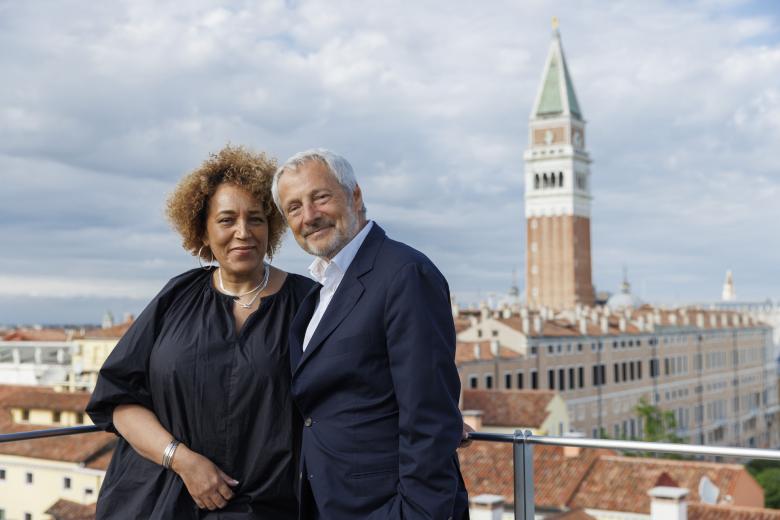Venice Biennale 'Attempts to Bridge the Gulf Between Architects and the Public'
In a press conference held on Tuesday, February 21, curator Lesley Lokko described details of the 18th International Architecture Exhibition, The Laboratory of the Future, that will open in May.
The words of this article's title came near the end of Lesley Lokko's comments at today's press conference (video embed is at bottom), when she said in full: “Curating a public-event program is increasingly a form of architectural practice that attempts to bridge the gulf between architects and the public.” Although Lokko was speaking specifically about the Carnival component of The Laboratory of the Future — the title she developed for the 18th International Architecture Exhibition that will focus on the twin themes of decolonization and decarbonization — the phrase could be applied to nearly any architecture exhibition, especially previous iterations of the widely popular and influential Venice Architecture Biennale. The Biennale setting allows Lokko to speak to an audience much greater than architects, academics, designer, engineers, and students — what she collectively calls “practitioners” — but also to give voice to people from Africa or the African Diaspora, “voices that have been silenced for so long”:
“It is often said that culture is the sum total of the stories we tell ourselves, about ourselves,” Lokko said. “Whilst it is true, what is missing in the statement is any acknowledgement of who the ‘we’ in question is. In architecture particularly, the dominant voice has historically been a singular, exclusive voice, whose reach and power ignores huge swathes of humanity — financially, creatively, conceptually — as though we have been listening and speaking in one tongue only. The ‘story’ of architecture is therefore incomplete. Not wrong, but incomplete. It is in this context particularly that exhibitions matter.”
Described as exhibition in six parts, The Laboratory of the Future boasts the following numbers that “reflect a seismic change in the culture of architectural production at large and an even greater shift in participation in international exhibitions”:
- 89 participants, over half of whom are from Africa or the African Diaspora
- 50/50 gender balance
- 43 is the average age of all participants (the youngest is 24)
- 46% of participants count education as a form of practice
- 70+% of exhibits are by practices run by an individual or a very small team
What follows is an outline of the exhibition's six parts, which will be accompanied by the 63 National Participations taking place in the Giardini and the Arsenale:
Force Majeure
“The Laboratory of the Future begins in the Central Pavilion in the Giardini, where 16 practices who represent a distilled force majeure of African and Diasporic architectural production have been gathered.”
The practitioners, in alphabetical order and in full: Adjaye Associates, atelier masomi, BASIS, Cave_bureau, Hood Design Studio, Ibrahim Mahama, Kéré Architecture, Koffi & Diabaté Architectes, MASS Design Group, Olalekan Jeyifous, SOFTLAB@PSU, Studio Sean Canty, Sumayya Vally and Moad Musbahi, Thandi Loewenson, Theaster Gates Studio, and urban American city (urbanAC).
Ugandan architect Doreen Adengo was slated to participate but sadly died last year after a long illness. “Her presence is deeply missed,” Lokko said.
Dangerous Liaisons
Located in the Arsenale, and also represented at Forte Marghera in Mestre, the “Dangerous Liasions” section is made up of “37 practitioners from around the world who work across disciplinary boundaries, geographies and new forms of partnership and collaboration.”
Among the 37 are: Liam Young, AMAA Collaborative Architecture Office for Research and Development, Estudio AO, Wolff Architects, Dream the Combine, Low Design Office, Ursula Biemann, Killing Architects, The Funambulist, Neri&Hu Design and Research Office, Office for Political Innovation, and SCAPE Landscape Architecture.
Curator's Special Projects
“There are 33 participants in this section, so-called because of their shared vision of architecture with the Curator and her Curator's Assistants.” The contributions are partitioned into a few topics:
- “Food, Agriculture and Climate Change,” including BothAnd Group, Gloria Pavia, and others.
- “Geography and Gender,” including Ines Weizman, J. Yolande Daniels, and others.
- “Mnemonic,” including Adjaye Associates with Kiran Nader Museum of Art, Looty, and others.
Guests from the Future
“Threaded through and amongst the works in both venues are [22] young African and Diasporan practitioners, our Guests from the Future, whose work engages directly with the twin themes of this exhibition, decolonization and decarbonization, providing a snapshot, a glimpse of future practices and ways of seeing and being in the world.”
Additionally, there are also three special participants “whose work complements the curator's footnotes”: filmmaker Amos Gitai, poet laureate Rhael “LionHeart” Cape, and photographer James Morris. Their work will be located at “key moments” in the Arsenale.
Carnival
Intentional or not, the press conference took place one day before Lent, when many people around the world celebrate Carnival. But rather than focusing on spectacle or entertainment, Lokko has conceived of the Biennal's Carnival as “a space of liberation.” Carnival will be “a six-month-long cycle of events, lectures, panel discussions, films, and performances, that explore the themes of the Biennale Architettura 2023,” all open to the public.
College
Last but not least is the the first-ever Biennale College Architecture, which was announced last month and received 986 applications for 50 spots before last week's deadline. Lokko will be joined by 15 other professors in undertaking a series of experimental studios, seminars, lectures and public reviews, with students working alongside practitioners, academics and policymakers on a variety of design projects. The whole will be filmed and turned into a documentary that will be released in October.
